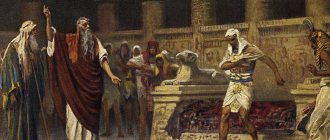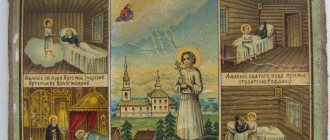How to enter a monastery
The future saint was born in 1812. The father of the future saint soon died, and Alexander, along with seven other brothers and sisters, was raised by his grandfather. From childhood, Alexander had a penchant for monastic life, prayer and deeds, but did not immediately decide on monastic obedience, deciding at first to become an ordinary priest. At the age of 12, the future saint entered the Tambov Theological School, then the seminary. It is known that in the last class of the seminary - just when it was necessary to decide on marriage and service as a priest in a parish or tonsure and service in a monastery - Alexander became very ill. In a life-threatening condition, he prayed a lot and made a vow to God to take monastic vows.
However, the future saint did not immediately fulfill his vow. After graduating from the seminary, he got a job as a teacher in the family of a local landowner, then taught at the Lipetsk Theological School. He said that he put off obedience for a long time, despite the reproaches of his conscience - after all, any saint is the same person as each of us; he is not an Angel and makes mistakes, sins, repents. The main difference between a holy person and a sinner is that he measures his whole life against God’s commandments, makes pleasing God his goal, and is ready for heroic deeds for this, that is, the deterioration of his living conditions, the renunciation of comfort. It is known that during his studies and work with the landowner, Alexander was the “life of the party”, sang well and even danced (which is surprising for a seminarian), moved a lot in secular society and knew the mood of the intelligentsia.
Thus, Saint Ambrose was not immediately enlightened by the grace of God, but he grew in holiness and was not able to immediately renounce worldly pleasures. Perhaps he even hoped to get married. The main turning point in the fate of the monk was the pilgrimage to the Trinity-Sergius Lavra, where he almost by chance met the spirit-bearing elder and ascetic. Confessing, he told about himself, and the ascetic blessed him to go to the recently opened Holy Vvedenskaya Optina Hermitage. Now the young man decisively broke ties with the world and left for the monastery, without even asking permission from the authorities of the school where he worked, and immediately entered the monastery for obedience. Thus began the difficult, sorrowful, but bright in the consolation of God, the path of the Monk Ambrose, the elder comforter of all Russia.
You can read the prayer to Ambrose of Optina about the right decision when entering a monastery and before monastic tonsure in Russian online:
O great elder and saint of God, our reverend father Ambrose, praise to the Optina Hermitage and to all Rus', teacher of piety! We glorify your humble life in Christ and the miracles with which God Himself exalted your name above other people even during your earthly life. He especially crowned you with heavenly honor after your departure from the mortal earth to the heavenly palaces of eternal glory. Accept now our prayers, your unworthy children (names) and the servants of God, who honor you and call your holy name, deliver us through your intercession before the throne of God from all sorrows and life difficulties, mental and physical illnesses, attacks of evil spirits and unrighteous people who corrupt and deceptive temptations. Send peace, silence and calm days to our Fatherland and Motherland from the grace of God, be invariably the patron of your holy monastery, where you yourself performed feats of prayer and pleased our God, glorified by all in the Trinity, to whom glory, honor and triumph belong, the Father, the Son, The Holy Spirit is eternal. Amen.
May the Lord protect you through the prayers of all saints!
Who can become a monk
People of different ages and social status come to monasteries. These could be beggars, mature women, old people or very young people. They are united only by the desire to repent and devote their lives to serving God. Another characteristic feature is an uncontrollable desire for self-improvement. All the people in the monastery are not losers, but energetic and determined. Only such a character will allow one to live a monastic life.
To escape from irritants, the predatory flycatcher creates a magnetic field around itself
Pensioners invented the “Useless Machine”, which was exhibited in the museum
Tolkalina's daughter has changed greatly. How Maria ate to lose 30 kg
About communal monasticism
The first monks were celibate Christians who lived in solitude on the edge of villages in prayer and contemplation of God, imitating the virtues of Christ . There were also those who, following the advice of St. Paul , took a vow of virginity. Essentially, the first monks are those who had a kind of talent for this unnatural-food way of life. It is significant that in the early days of monasticism there were almost no women ascetics, which was apparently due to a greater natural predisposition to family life than men. However, by the third century there were small communities of virgins (of all ages) who were under the special care of church communities.
Reproduction of the icon “Apostle Paul” by Andrei Rublev from the collection of the State Tretyakov Gallery. Photo: RIA Novosti / Vladimir Vdovin
Monasticism flourished and took its strong place in church life thanks to two amazing people who lived in Egypt in IV. These are Anthony and Pachomius , called the Great - two very different people, but it was they who were able to transform their experience of Christian solitary life into some kind of system, or something, and this made it possible to pass on this experience to others. Anthony began to live far from the villages, in a deserted place, and became the first who allowed those who wanted to settle around him, the first who became a mentor to the monks. Of course, not everyone settled around Anthony, but people more or less capable of a solitary prayer life. The center of their life is unceasing prayer and contemplation of God. In fact, the community of St. Anthony was a special one, where he was the spiritual mentor over everyone and had general supervision. The brethren gathered once a week for common prayer. If a priest came, then they communed with the Body and Blood of Christ. Everything else was independent. Each monk had his own home, dressed and fed himself. Passive life attitudes were impossible here. Under Anthony, for example, a man who had difficulty choosing a wife could not settle.
The monasteries of St. Pachomius are another matter. He is the founder of the so-called cenobitic, or more precisely, communal, monasticism. Pachomius created a fairly rigid system that allowed ordinary people to become monks. The genius of Pachomius is that, with the help of God, he found the only way to make monasticism widespread. Tradition says that the first charter of the monastery was brought to Pachomius by an Angel. The hermit, being quite zealous, objected: “Are there not enough prayers in your rule?” “No, everyone must follow this rule,” answered the Angel.
The result was a complete system for those desiring monastic life. It included, firstly, almost absolute isolation. Any temptations associated with the opposite sex were thus minimized. Secondly, life in the monasteries of Pachomius presupposed non-covetousness. Everyone, even the abbot, is equal in terms of property. Envy and encroachment on other people's “good” thereby became irrelevant. Thirdly, very specific types of work were established for the monks, and depending on the work performed, all the inhabitants of the monastery were divided into groups. If someone was not so talented at prayer, but wanted to live a monastic life, then there was a place for him in this community. Fourthly, a fully scheduled life schedule and almost absolute obedience to the abbot and spiritual leaders put the final touch on the system’s closeness to external and internal disturbances.
Thus, a stable, replicable system appears, capable of instilling in the institution of monasticism even those who have not yet made the final choice between worldly life and hermitage, who are only drawn to Christian maximalism (in the best sense of the word). Although, of course, only those who showed personal free will and passed a fairly tough test could become monks. Violence is impossible in Christianity.
It was the communal system that made mass female monasticism possible. Pachomius the Great also helped create convents with several thousand (!) nuns in each.
Article on the topic
Brothers in spirit and flesh.
Twin monks write doctorates and save orphans. However, there are “costs” along the way. The temptation for many can be not only sin, but also virtue beyond measure. A story has come down to this day from ancient manuscripts about how a hermit known at that time named Macarius wanted to learn from experience how they lived in the monasteries of Pachomius.
He was accepted. Accustomed to eating almost once a week, and in the period before Easter in memory of the suffering of Christ and less often, Macarius ate as usual in the monastery. Having apologized, Pachomius removed Macarius from his monastery. In this case, averageness is higher than feats. The smooth course of life for most is more important. Most of the monks came from the common people, and the communal living conditions were quite acceptable for them. Other people could settle in special monasteries. , a monk named Arseny lived in solitude . He is also called the Great. He had a soft bed. This tempted many. Once someone said to Arseny: “What is it, they say, everyone on earth sleeps with a log under their head, but are you different?” Arseny replied that this brother, being a poor commoner, always slept on a log and gave up little in life for the sake of monasticism. And Arseny himself came to these lands from afar and was the teacher of the royal children. Arseny left not only the luxurious beds, but also his entire fortune, fame, and power. This case shows that the hermit system was quite soft. In a hostel system this would be impossible.
It can be argued that monasticism, ideally, is constantly associated with a sincere desire to serve God and imitate Christ the Savior throughout life. This desire can be a gift from above, a talent - and then there is no need for regulations and frameworks. If the desire is weak, like some kind of craving, then only a hostel with its protective system is possible.
He tonsured five novices of the Seraphim-Sarov Monastery as monks in the village of Novo-Makarovo, Gribanovsky district, Voronezh region, 2008. Photo: RIA Novosti / Andrey Arkhipov
Procedure
If the decision is made and the blessing of the confessor is received, the woman can begin the procedure of preparing for monasticism. First of all, you need to resolve property, legal and family matters (to whom to transfer real estate, documents, pets), settle all issues with relatives and everyone who depends on you and is attached to you. Important: married people are not accepted into monasticism. Any experienced and intelligent priest will tell you that if a person is in a prosperous family relationship and at the same time wants to become a monk, it is likely that he is following the wrong path and he should not do it. If a woman is alone and has minor children, then it is also better to postpone the question of monasticism until later. Many people make the mistake of taking their children to a monastery for pious reasons, but it is worth remembering that monasticism is an entirely voluntary matter and you should not make a child hostage to your decisions. This may bring less than godly results.
After the blessing has been received and matters have been settled, you should go to the monastery to talk with the abbess. The usual documents that are required for the monastery are a passport, an autobiography, a certificate of death of the husband, if the woman is a widow, a petition for admission to the monastery. Usually, tonsure is allowed to those who have already reached the age of thirty. If a woman leaves minor children in the world (which is undesirable), a certificate of guardianship will be needed.
You cannot take monastic vows immediately upon arrival at the monastery - as a rule, there is a probationary period of three to five years. During this period, a woman goes through certain stages of life in the monastery. At first she becomes a laborer. At this stage, it will be necessary to carry out any work assigned to her (washing, cleaning, agricultural work, cooking, etc.). Plus – attending religious services. Usually this stage lasts three years and it is during this time that a person decides whether to stay in the monastery or not. If a woman decides to stay, she becomes a novice - that is, one who is preparing to take monastic vows. To do this, a petition is written addressed to the abbess of the monastery. Novices wear a black cassock as a symbol of upcoming monasticism. In addition to physical labor and prayers, novices also mentally prepare for a more serious ascetic feat. The duration of this stage is determined individually, and during this period you can still decide to leave the monastery. If the abbess and novice understand that the woman is ready for tonsure, and her desire for monasticism has strengthened, the abbess writes a petition addressed to the bishop and the woman receives tonsure. Along with tonsure, a woman takes a new name and makes several vows: a vow of obedience (renunciation of self-will), a vow of celibacy (refusal of sexual activity), a vow of non-covetousness (renunciation of property). In addition, the nun undertakes to undertake an unceasing feat of prayer.
Content
Monasticism is not formally included among the Church Sacraments, but in essence it is: in tonsure, a person takes vows and changes, even changing his name. To some extent (very carefully) monasticism can be called a second Baptism. Unfortunately, just as some are baptized without realizing the true meaning of this Sacrament, so monasticism is often completely misunderstood.
It is a naive and completely erroneous idea that monasticism in itself makes a person closer to the Kingdom of Heaven. The well-known story of the Alexandrian shoemaker, who through simple family piety succeeded in acquiring salvation more than a desert monk, testifies that the laity are no more sinful than the monks. Monasticism is a way of life and, so to speak, a focus on salvation.
Strange as it may seem, there are people who strive to make a church career in monasticism. Men want to become abbots and then bishops, women want to become abbess. Let’s not consider them ordinary ambitious people: most often in such cases, the seeker of monasticism hopes to benefit the Church, build something new, break imperfect orders, and so on.
Secondly, the Church does not need to be saved, it needs to be saved in it. That is, trying to protect the Church as your religious community, to overcome some difficulties is a completely worthy thing. But you need to do this in your place, not rush somewhere. This is that very Christian humility, without which it is impossible to be saved.









